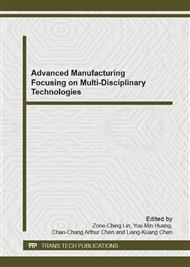[1]
S.C. Terry, J.H. Jerman, J.B. Angell, A gas chromatographic air analyzer fabricated on a silicon wafer, IEEE Trans. Electron Devices 26 (1979) 1880-1886.
DOI: 10.1109/t-ed.1979.19791
Google Scholar
[2]
A.W. Martinez, S.T. Phillips, Wiley B.J. Wiley, M. Gupta, Whitesides G.M. Whitesides, 2008. FLASH: a rapid method for prototyping paper-based microfluidic devices, Lab on a chip, 8 (2008) 2146-2150.
DOI: 10.1039/b811135a
Google Scholar
[3]
W. Ehrfeld, H. lehr, F. Michael, A. Wolf, H. -P. Gruber, A. Berthholds, Microelectro discharge machining as a technology in micromachining, Proceedings of SPIE- The International Society for Optical Engineering, 2879 (1996) 332-337.
DOI: 10.1117/12.251221
Google Scholar
[4]
A.E. Guber, M. Heckele, D. Herrmann, A. Muslija, V. Saile, L. Gietzelt, W. Hoffmann, P.C. Hauser, J. Tanyanyiwa, A. Gerlach, N. Gottschlich, G. Knebel, Microfluidic lab-on-a-chip systems based on polymers-fabrication and application, 101 (2004).
DOI: 10.1016/j.cej.2004.01.016
Google Scholar
[5]
T.D. Boone, Z.H. Fan, H.H. Hooper, A.J. Ricco, H. Tan, S.J. Williams, Plastic advances microfluidic devices, 74 (2002) 78A-86A.
Google Scholar
[6]
S.A. Soper, S.M. Ford, S. Qi, R.L. Mccarley, K. Kelly, M.C. Murphy, Polymeric microelectromechanical systems, 72 (2000) 643A-651A.
Google Scholar
[7]
B.H. You, P.C. Chen, D.S. Park, S. Park, D.E. Nikitopoulos, S.A. Soper, M.C. Murphy, Passive micro-assembly of modular, hot embossed, polymer microfluidic devices using exact constraint design, 19 (2009) 125025.
DOI: 10.1088/0960-1317/19/12/125025
Google Scholar
[8]
M.L. Hupert, W.J. Guy, S.D. Llopis, C. Situma, S. Rani, D.E. Nikitopoulos, S.A. Soper, High precision micromilling for low cost fabrication of metal mold masters, Proceedings of SPIE- The International Society for Optical Engineering, 6112 (2005).
DOI: 10.1117/12.647135
Google Scholar
[9]
M.L. Hupert, W.J. Guy, S.D. Llopis, C. Situma, S. Rani, D.E. Nikitopoulos, S.A. Soper, Evaluation of micromilled metal mold masters for the replication of microchip electrophoresis devices, Microfluid Nanofluid, 3 (2007) 1-11.
DOI: 10.1007/s10404-006-0091-x
Google Scholar
[10]
D.S. Zhao, B. Roy, M.T. McCormick, W.G. Kuhr, S.A. Brazill, Rapid fabrication of a poly(dimethylsiloxane) microfluidic capillary gel electrophoresis system utilizing high precision machining, Lab Chip, 3 (2003) 93-99.
DOI: 10.1039/b300577a
Google Scholar
[11]
J.S. Mecomber, A.M. Stalcup, D. Hurd, H. B. Halsall, W. R. Heineman, C. J. Seliskar, K. R. Wehmeyer, P. A. Limbach, Analytical Performance of Polymer-Based Microfluidic Devices Fabricated By Computer Numerical Controlled Machining, Anal. Chem, 78 (2006).
DOI: 10.1021/ac051523y
Google Scholar
[12]
J. S. Mecomber, D. Hurdb, P. A. Limbach, Enhanced machining of micron-scale features in microchip molding masters by CNC milling, International Journal of Machine Tools & Manufacture 45 (2005) 1542–1550.
DOI: 10.1016/j.ijmachtools.2005.01.016
Google Scholar
[13]
K. B. Mullis; Faloona, F. A Faloona, Specific synthesis of DNA in vitro via a polymerase-catalyzed chain reaction, Methods Enzymol. 155 (1987) 335–350.
DOI: 10.1016/0076-6879(87)55023-6
Google Scholar
[14]
P. J. Obeid, T. K. Christopoulos, H J Crabtree, C. J. Backhouse, Microfabricated device for DNA and RNA amplification by continuous-flow polymerase chain reaction and reverse transcription-polymerase chain reaction with cycle number selection, Anal. Chem., 75 (2003).
DOI: 10.1021/ac0260239
Google Scholar
[15]
D. J. Sadler, R. Changrani, P. Roberts, C. F. Chou, F. Zenhausern, Thermal management of Bio-MEMS: Temperature control for ceramic-based PCR and DNA detection devices, IEEE Tr Comp Pkging Tech, 26 (2003) 309-316.
DOI: 10.1109/tcapt.2003.815093
Google Scholar
[16]
H. Nagai, Y. Murakami, Y. Morita, K. Yokoyama, E. Tamiya, Development of a microchamber array for picoliter PCR, Anal. Chem., 73 (2001) 1043-1047.
DOI: 10.1021/ac000648u
Google Scholar
[17]
M. Hashimoto, P.C. Chen, M.W. Mitchell, D.E. Nikitopoulos, S.A. Soper, M. C Murphy, Rapid PCR in a continuous flow device, Lab Chip 4 (2004) 638-645.
DOI: 10.1039/b406860b
Google Scholar
[18]
P. -C. Chen, D. E. Nikitopoulos, S. A. Soper, M. C. Murphy, Temperature distribution effects on micro-CFPCR performance, Biomed. Microdevices, 10 (2008) 141-152.
DOI: 10.1007/s10544-007-9119-6
Google Scholar
[19]
P. -C Chen, D.S. Park, B.H. You, N. Kim, T. Park, S.A. Soper, D.E. Nikitopoulos, M.C. Murphy, . Titer plate formatted continuous flow thermal reactors: design and performance of a nanoliter reactor, Sensors and Actuators B: Chemical, 149 (2010).
DOI: 10.1016/j.snb.2010.05.068
Google Scholar
[20]
A.E. Guber, M. Heckele, D. Herrmann, A. Muslija, V. Saile, L. Eichhorn, T. Gietzelt, W. Hoffmann, PC. Hauser, J. Tanyanyiwa, A. Gerlach, N. Gottschlich, G. Knebel, Microfluidic lab-on-a-chip systems based on polymers—fabrication and application, Chem Eng J, 101(1–3) (2004).
DOI: 10.1016/j.cej.2004.01.016
Google Scholar
[21]
T. Schaller, L. Bohn, J. Mayer, K. Schubert, (1999) Microstructure grooves with a width of less than 50 um cut with ground hard metal micro end mills, Precis Eng, 23 (1999) 229–235.
DOI: 10.1016/s0141-6359(99)00011-2
Google Scholar


